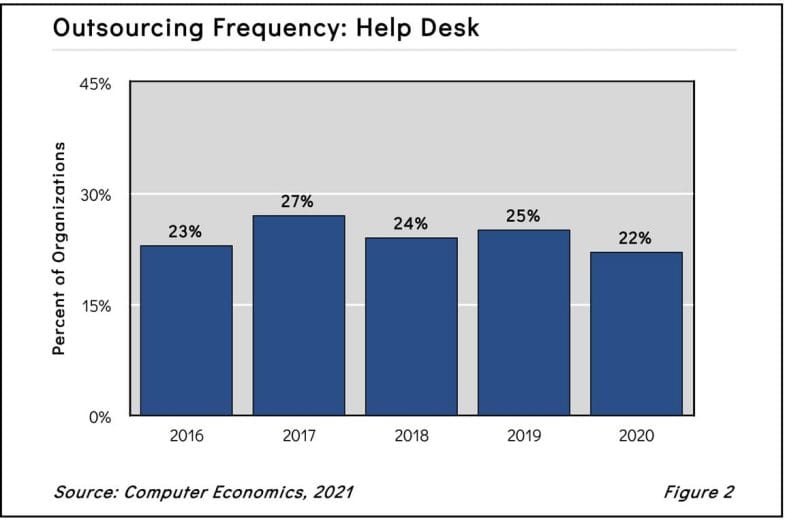The decision to turn over an IT organization’s help desk function to a service provider has a long history. Nevertheless, our research shows that it is not as pervasive as one might think. The percentage of organizations outsourcing their help desks at any level declined again for the third straight year. One factor here is that many support tasks have become easier to perform and can be done remotely.
The number of companies outsourcing IT help desk work has been down since its recent peak of 27% in 2017. As shown in Figure 2 from our full report, IT Help Desk Outsourcing Trends and Customer Experience, approximately 22% of organizations now outsource at least some of their help desk work. That percentage is down markedly from three years ago.

Help desk technicians are increasingly handling PC issues remotely, reducing the need for on-site staff or outsourced help desk personnel. Software as a service (SaaS) applications and desktop virtualization mean that there are fewer business applications running on the user’s local desktop or laptop. On the operating system front, the latest version of Microsoft Windows, which still runs on the majority of desktops and laptops, is more reliable and easier to maintain than previous versions. Finally, remote systems-management software is reducing support costs. In the future, self-diagnostics, self-healing, and self-support systems promise to further control the cost of help desk support.
“Interestingly, our research also shows that internal help desk staff as a percentage of the total IT staff has been increasing in recent years,” said Tom Dunlap, director of research for Computer Economics, a service of Avasant, based in Los Angeles. “That’s additional evidence of the trend we’re seeing here: As systems become easier to support, IT organizations have been pulling this work back in house.”
In this report, we define IT help desk outsourcing as contracting with a service provider to provide support for users of an organization’s IT systems. We do not include help desk operations that provide support to external customers for the company’s products or services. For example, the customer service group for a software vendor or a telecommunications provider would not be included in our definition of the IT help desk function.
In the best-run IT organizations, the help desk is the primary day-to-day point of contact between users and the IT organization. The help desk also can perform related functions such as asset management, training, tracking user satisfaction, and system monitoring. These activities are more difficult for the help desk to perform when the function is outsourced.
IT executives need to consider their help desk strategies in light of current trends. Our full report measures help desk outsourcing activity through outsourcing frequency, level, volatility, net growth trend, cost experience, and service experience. It also compares help desk outsourcing frequency and level by organization size. Finally, the report examines the sectors that are most likely to outsource the help desk function and concludes with some key questions to consider.
This Research Byte is a brief overview of our study, IT Help Desk Outsourcing Trends and Customer Experience. The full report is available at no charge for subscribers, or it may be purchased directly from our website (click for pricing).




